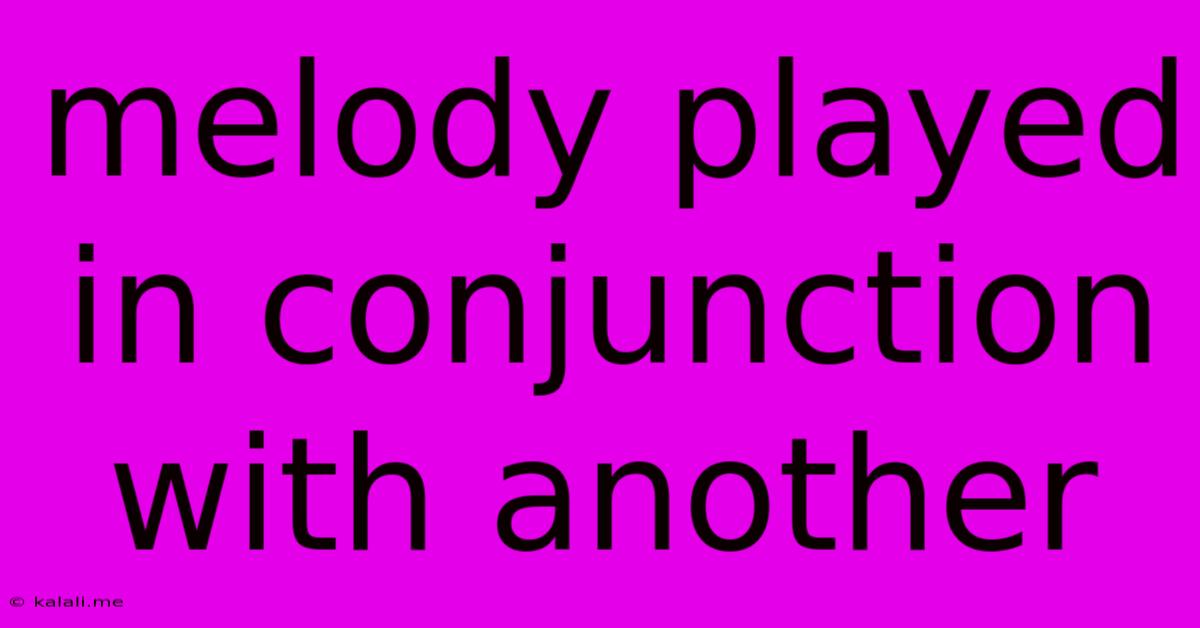Melody Played In Conjunction With Another
Kalali
May 19, 2025 · 3 min read

Table of Contents
The Art of Polyphony: When Melodies Dance Together
Meta Description: Explore the fascinating world of polyphony, where multiple melodies intertwine to create rich and complex musical textures. Learn about different polyphonic techniques and their impact on musical expression.
The beauty of music often lies in its ability to evoke emotion, tell stories, and transport us to different realms. While a single melody can be captivating, the magic truly unfolds when multiple melodies are played concurrently, a technique known as polyphony. This article delves into the world of polyphony, exploring how different melodies interact, the techniques employed, and the resulting impact on the overall musical experience.
Understanding Polyphony: More Than Just Harmony
Polyphony differs significantly from homophony, where a single melody is accompanied by chords. In polyphony, each melodic line retains its independence, creating a complex tapestry of sound. Think of it as a conversation between multiple voices, each with its own distinct character and contribution to the overall narrative. This independent melodic movement is crucial to defining polyphony. Even when harmonies are involved, the individual melodic lines remain distinguishable and contribute equally to the musical fabric.
Techniques Used in Polyphonic Composition
Several techniques contribute to the success of polyphonic compositions:
-
Counterpoint: This is the cornerstone of polyphony. Counterpoint involves weaving independent melodic lines together, creating interplay and tension between them. Different types of counterpoint exist, from simple imitative counterpoint to complex canons and fugues. Understanding counterpoint is crucial for creating effective polyphonic textures.
-
Imitation: This technique involves presenting a melodic idea in one voice, followed by its repetition in another voice, often at a different pitch or rhythm. This creates a sense of unity and continuity while maintaining individual melodic character.
-
Canon: A canon is a stricter form of imitation where one melodic line is exactly repeated by another, typically after a specific time interval. Round songs are a familiar example of a simple canon.
-
Fugue: A fugue is a highly complex polyphonic form characterized by a subject (main melodic idea) that's presented in different voices, often with interwoven counter-melodies and episodes of development. Bach's fugues are prime examples of this intricate compositional technique.
-
Harmony: While individual melodies maintain their independence, harmony plays a crucial role in creating cohesion and aesthetic appeal. The harmonic relationships between the different melodic lines influence the overall mood and feel of the piece.
The Impact of Polyphony on Musical Expression
The use of polyphony dramatically expands the expressive possibilities of music. It allows composers to:
-
Create richer textures: The interplay of multiple melodies generates a sonic density and complexity that surpasses single-melody compositions.
-
Develop complex musical narratives: Independent melodic lines can represent different characters, ideas, or emotions, leading to a richer and more layered storytelling experience.
-
Enhance emotional depth: The interplay of contrasting melodies can create tension, resolution, and a wide range of emotional responses in the listener.
Examples of Polyphony in Different Genres
Polyphony is found across many genres and historical periods. From the Renaissance motets of Josquin des Prez to the Baroque works of Johann Sebastian Bach, polyphony has been a central element in Western classical music. However, polyphonic elements also appear in various other genres, including jazz, folk music, and even some forms of popular music. The use of layered vocals in modern pop music is a prime example of polyphonic elements working in popular musical settings.
Conclusion: The Enduring Power of Interwoven Melodies
Polyphony represents a pinnacle of musical artistry, demonstrating the incredible potential for creativity and expression when multiple melodies converge. Its enduring influence on musical history speaks to its power to move, inspire, and engage listeners in a way that few other musical techniques can achieve. Understanding the principles of polyphony provides a deeper appreciation for the complexity and beauty of music.
Latest Posts
Latest Posts
-
How To Address Two Person In Email
May 19, 2025
-
What To Use Instead Of Tin Foil In Oven
May 19, 2025
-
Faint Heart Never Won Fair Lady
May 19, 2025
-
Can You Top Up Engine Oil Without Draining
May 19, 2025
-
How Does A Step Up Transformer Work
May 19, 2025
Related Post
Thank you for visiting our website which covers about Melody Played In Conjunction With Another . We hope the information provided has been useful to you. Feel free to contact us if you have any questions or need further assistance. See you next time and don't miss to bookmark.